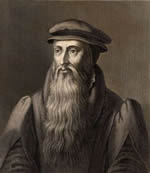 |
|
 |
John Knox |
|
John Knox House, Edinburgh |
John Knox, the most famous Scottish Reformer, was born near Edinburgh in 1505. He went to his local school and then to university in St Andrews, before becoming a deacon and a priest in the (Roman Catholic) Church.
From 1542, Scotland was governed by Regent Arran as Mary Queen of Scots [link to First Reformation – Monarchs – Mary QOS] was still a baby. Arran benefited reform in Scotland in a number of ways. Firstly, he passed a law that allowed people to read the Bible in their own language. He then appointed the Protestant Thomas Guillame to preach around Scotland, and it was through his preaching that John Knox was converted. The biggest influence on Knox’s life however was George Wishart.
After Wishart’s death in 1546, Knox taught the sons of a number of Protestants who had captured St Andrews Castle. Some of those in the castle called Knox to become their minister. At this he burst into tears and ran off to his room because of what a responsibility he knew it would be. A few days later however he accepted the call. In the summer of 1547 French warships attacked the castle. Knox was taken prisoner, kept aboard in one of the ships and forced to row it in chains with other galley slaves. After 19 months however he was set free, and went to England where Archbishop Cranmer was working to promote the Reformation, and he was appointed as a preacher [in Berwick]. He attacked the Roman Catholic mass as idolatry because it was ‘invented by the brain of man’ and not commanded by God. In 1551 he was invited to live in London and preach before king Edward VI.
In 1553, the Roman Catholic Mary I became Queen. Knox was now in danger so he left for Europe. He became minister in Frankfurt in Germany and then in Geneva in Switzerland where John Calvin was also a minister. In between he returned to Scotland to get married and preach, and was surprised at how far the teaching of the Reformers was spreading.
In 1559, he came back to Scotland for good. The Scottish people were now ready to end Roman Catholicism once and for all, after the death of Walter Mill. Knox began to preach throughout Scotland, and God saved many people. In the autumn, he became minister at St Andrews. The people in St Andrews had been convinced by Knox’s preaching and had taken all the pictures and images out of the church.
1560 was the key year in the First Scottish Reformation. The Scottish Parliament passed laws getting rid of the mass and the Pope’s power in Scotland. Knox and five other men, all called John, wrote important documents such as the Scots Confession of Faith, which explained what the church believed. In the summer, Knox became minister in Edinburgh. In December, the first General Assembly met in Edinburgh.
From 1567 until he was assassinated three years later, Scotland was ruled by the Protestant Regent Moray. The second Reformation Parliament met in the same year and passed more laws in favour of the Reformation. The years from 1560 onwards saw worship simplified, evangelism, care of the poor and more education, so the ordinary people could read the Bible. Instead of the outward forms of Roman Catholicism, public worship was now based around reading, preaching and singing from God’s word.
Knox continued preaching for the rest of his life and died in 1572. When he was buried, it was said that ‘Here lies a man who in his life never feared the face of man’.
Application
John Knox saw how important it was for the church to do what the Bible said, and not just what they thought was right. He wasn’t afraid to stand up to anyone, even kings and queens, for what he knew was right. His preaching was used by God to transform the whole of Scotland.
Read more:
John Howie, ‘John Knox’ in The Scots Worthies (Edinburgh, 2001 [1775]), pp 48-66.
J. G. Vos, The Scottish Covenanters (Edinburgh, 1998 [1940]), pp 19-29.
Thomas M’Crie, The Life of John Knox (Edinburgh, 1811).
John Knox, History of the Reformation in Scotland ed. W. C. Dickinson (2 vols, 1949).
Knox, John, The Works of John Knox ed. David Laing (Edinburgh: Wodrow Society, 6 vols (1846–64)
DSCHT: Knox, John
Jane E. A. Dawson, ‘Knox, John (c.1514–1572)’, Oxford Dictionary of National Biography, Oxford University Press, Sept 2004; online edn, Jan 2008
Marcus Merriman, ‘Hamilton, James, second earl of Arran, and duke of Châtelherault in the French nobility (c.1519–1575)’, Oxford Dictionary of National Biography, Oxford University Press, 2004
Mark Loughlin, ‘Stewart, James, first earl of Moray (1531/2–1570)’, Oxford Dictionary of National Biography, Oxford University Press, 2004
|